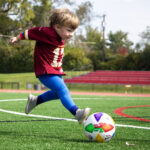December 30, 2025
Reducing Holiday Stress for Families of Children with Autism

FEATURED POSTS
December 15, 2025
December 11, 2025
The holidays are as joyful as they are stressful, or is it the other way around?
The stress of the holidays, visiting family members, and all that comes with the season can be a lot to deal with under any circumstances. When caring for a loved one with autism or other developmental challenges, this time of year can feel overwhelming as it creates disruption to the routines and structure of your family’s life.
Here are some helpful strategies to lessen your child’s anxiety and increase your family’s enjoyment of the holiday season:
Shopping:
Holiday shopping, and especially last minute trips to huge department stores, can be over stimulating and stressful for individuals who cannot tolerate too many sounds, bright lights or large groups of people. If you do take your child shopping with you, allow enough time to gradually adapt to the intense holiday stimuli that stores exhibit at this time of year. Planning multiple short shopping trips is a good idea, and be prepared to leave before you have completed your list if your child can no longer tolerate the environment.
Decorating:
Individuals with autism typically struggle with changes to their environments. Keeping this in mind, decorate your home in gradual stages, rather than changing everything at once. Include your child by having him interact with the decorations and do some of the decorating himself. Some children may be disturbed by decorations with flashing lights and music. Allow your child to experience these in a store or in a quiet place first to determine if he can tolerate them, and how many.
Family Routines:
Maintaining your typical family routines as much as possible during the holiday season will result in fewer behavioral disruptions and less anxiety for the family as a whole. This is often tough to do with travel, visitors in your home, and long family gatherings. If your child can predict and understand what is going to happen, he will manage the celebration far better. Writing a story or using some visual supports (photos, drawings) to show how the day will unfold will allow him to practice some social behaviors. A visual schedule will also give you a tool to use for reference during the day, reminding him what is going to happen next (when he will get to open toys etc). This type of system creates independence and structure within a typically more unstructured setting.
Gifts:
Gifts are tempting to all of us. Create opportunities to teach (and remind) that gifts will be opened during specific times during the family ritual of getting together. For families celebrating a holiday such a Hanukkah, where children may receive gifts on multiple nights, try using a visual schedule to show your child which nights he will get to open a gift and which nights he will not. We suggest waiting until just before the holiday to put gifts out to reduce the temptation for opening them. You can also practice a family ritual of taking turns opening gifts so your child learns to wait his turn and learns to predict when it is his turn to open a gift.
Your child may not be inclined to share their toy or may immediately want to play with another child’s toy. This can cause disruption and chaos so plan ahead, perhaps selecting one toy to be shared while the others are set aside or bring another new toy with you to share with the other children.
Make it Your Own:
It is important to identify what the meaning of the holiday is for you and your family and how you want to honor that- your special ritual, celebration, event. Once you have identified what that looks like, you can begin practicing ahead of time with your child and your family and extended family members what you and your child will need to make that event successful. We hope that some of the tips we have provided will help you and your family experience a peaceful, joyful and meaningful holiday season.
Watch our Holiday Parent Video for more helpful tips.





